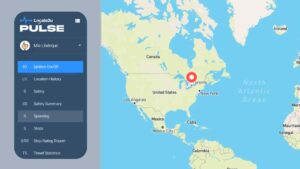Last mile delivery is changing, mostly due to new technology available and businesses’ willingness to invest in more cost-effective and faster deliveries.
The $136.6 billion package delivery industry is ripe for automation. However, many workers fear that they might lose their jobs to technology. The World Economic Forum predicts that by 2025, 85 million jobs may be displaced, but 97 million new roles will emerge.
Robot couriers, electric vehicles, drones, smart lockers, wearable technology, and cloud computing are just a few of the technology innovations being researched and invested in to grow the delivery experience.
In this article, we’ll explore 18 technology trends shaping the final mile delivery process.
1. Drone last mile delivery is fast
The ultralight and light aircraft (which includes drones) market is estimated by a new report by MarketsandMarkets to be worth USD 17.29 billion by 2029. The driving force behind it? Its low transportation costs and maintenance.
Drones are fast, low cost and can maneuver into tight spots better than big bulky vans can. Drones also don’t have to adhere to traffic rules, like red lights. This cuts down the delivery speed significantly.
It’s also more cost-effective when it comes to labor costs. A single drone pilot can oversee up to 50 drones simultaneously, allowing for rapid scaling of deliveries.

2. Robotic couriers on the rise
City life and sky-scraping buildings, with lifts and elevators, make the last few steps of the last-mile delivery “very interesting,” says Navinda Kottege, research director for robotics at CSIRO’s Data61 project.
You now find two-, four-, and six-legged robots being introduced to society. The only problem is funding. At the moment, countries like Australia and America are investing in robot technology to improve the last mile delivery experience.
CSIRO says several companies are investing in developing these legged systems because they are more affordable in the long run.
3. Artificial intelligence (AI) transforms e-commerce
DHL Express uses AI to improve speed and accuracy by forecasting shipping volumes and achieving precision in courier route planning. It believes AI helps it to prioritize urgent or time-sensitive deliveries.
The giant logistics company says AI is changing the last mile delivery experience in three prominent ways.
- Optimizing routes.
- Predictive demand forecasting.
- Improves customer experience.
AI-driven algorithms optimize delivery routes by analyzing real-time traffic, weather, and priorities, cutting delivery times and fuel consumption.
Predictive demand forecasting allows businesses to adjust inventory levels accurately and speed up the last-mile delivery time.
AI also improves customer experiences by offering real-time order tracking and flexible delivery options.

4. Machine Learning (ML)
Machine Learning algorithms are changing the last-mile scene by processing vast amounts of delivery data to predict traffic patterns, optimize routes, and allocate resources efficiently.
This leads to faster delivery and more reasonable delivery costs.
For example, FedEx uses ML to forecast package demand and streamline delivery routes. This is especially used during peak seasons by analyzing the spike in demand over the year and comparing it to the previous season.
5. Internet of Things (IoT)
IoT devices like smart sensors and trackers provide real-time visibility into vehicle locations and package conditions. This helps to identify and fix delivery issues before they escalate.
DHL uses IoT sensors for temperature-sensitive deliveries. This could be something like pharmaceuticals which need to be kept at optimal conditions during last mile deliveries.
6. Blockchain benefits last mile delivery
Blockchain technology enhances transparency and security. It records transactions across multiple computers, ensuring data transparency, immutability, and security.
Danish logistics firm Maersk employs blockchain for end-to-end supply chain tracking, ensuring authenticity and reducing disputes in last-mile logistics.
7. Big Data analytics
By analyzing consumer behavior and delivery performance, Big Data helps businesses to improve their delivery strategies. They can also forecast demand, and offer tailored services for improved customer satisfaction.
This is how Amazon, for instance, can predict popular product categories and preferred delivery windows to make the last mile delivery faster and more efficient. If they can predict what products will be popular, they won’t run out of stock.

8. Mobile applications
Most customers prefer online shopping on their phones.
For customers to use mobile apps to shop online enhances their customer engagement. This technology allows customers to receive real-time delivery updates, and communication with delivery drivers right up until it reaches the customer’s door.
Without apps, last mile services in the food industry can become frustrating. New technology features are released on apps that constantly improve the last mile delivery process for customers.
The Zomato app allows customers to schedule their orders up to two hours or two days in advance.
9. Cloud Computing shapes last mile delivery
Uber Eats and FedEx are good examples of delivery companies receiving millions of orders daily. They use cloud computing to handle high volumes of orders and provide seamless updates to customers and drivers in real-time.
Cloud systems integrate with warehouse management software and automated sorting technologies to categorize orders based on delivery zones, sizes, or deadlines.
10. Electric Vehicles (EVs) for sustainable last mile delivery
Electric vehicles are reducing carbon emissions. According to the International Energy Agency, the transport sector accounts for more than a third of CO2 emissions from end‐use sectors.
In Australia, the Renewable Energy Agency (ARENA) is spending $100 million to help shift heavy vehicles to electric power.
ALSO READ: ‘Prime Polluter’: Is Amazon’s climate pledge just five years of hot air?

11. Is smart warehousing the future?
“Warehouse automation has been a hot topic lately. It is not enough to rely on traditional sortation and conveyor systems,” says Maersk’s global head of innovation, Erez Agmoni.
There is an unprecedented speed that’s taking over the pick and pack processes in Maersk warehouses.
It’s using drones to improve inventory management in traditional facilities. This is improving their accuracy and efficiency.
Maersk is also using warehouse automation in traditional racking systems to lift and transport goods across the warehouse, avoiding the use of additional floor space.
12. Geofencing helps the final mile
Geofencing helps to improve the ETA, driver safety and real-time updates. The virtual borders around a location or place help to monitor when a mobile device enters or exits a geofenced area.
This improves the communication between customers and drivers.
Locate2u‘s chief of product, Mark Power, says geofencing tech can mark deliveries as completed when the driver exits a geofence.
“Maybe if the driver leaves 100 m from that delivery point, it can automatically complete that delivery.”
ALSO READ: How can my business benefit from geofencing?

13. Smart lockers on four legs for delivery
Smart lockers provide security and convenience and are also environmentally friendly. It’s gaining massive popularity worldwide.
According to DHL, these smart parcel lockers are “quietly transforming e-commerce logistics.”
DPD has taken it one step further and is now providing the UK’s first locker on wheels. It’s like a robot, but for parcels.
14. Telematics for last mile delivery
Telematics technology uses GPS and onboard diagnostics to monitor vehicle performance and driver behavior in real-time.
You want to track metrics like:
- Speed,
- Fuel consumption,
- Braking patterns.
This way you can optimize your fleet performance. Telematics reduce the wear and tear and ultimately… improve delivery times.
UPS uses telematics, and you’ll be surprised how the last mile delivery speed can increase by simply having a more reliable fleet
It’s understood that the courier’s problems with the vehicle can easily be sorted with telematics.
15. Predictive analytics improves delivery process
Predictive analytics look at historical and real-time data. This helps to forecast demand, enabling businesses to allocate resources effectively.
The last thing you want is to have last mile delivery delays. When there is sufficient inventory and staff availability during peak times, this can be avoided.
Walmart uses predictive analytics to anticipate demand spikes and streamline its last-mile logistics. This way, there are minimal disruptions during peak periods.
16. Digital twins increase same day delivery speed
What is digital twin technology? It creates virtual replicas of delivery networks. It allows companies to test and optimize logistics strategies without disrupting actual operations.
Why is this important to help with last mile delivery? It simulates scenarios like traffic patterns or warehouse workflows. This way, businesses can identify inefficiencies and fix them.
DHL uses digital twins to optimize its supply chain operations, leading to smoother last-mile delivery processes.

17. Voice assistants improve delivery efficiency
Voice assistants simplify last-mile delivery tasks. It helps drivers to focus on all the multiple tasks during a delivery.
“A safer working environment while increasing efficiency and margins are extremely compelling reasons for companies to invest in this technology,” says Holger Weiss, CEO at German Autolabs.
This is how it works: Drivers can use voice commands to update routes, check delivery instructions, or confirm completed deliveries.
18. Wearable technology improves last mile delivery
Amazon is working on wearable delivery glasses so that drivers can improve their speed. Delivery drivers visit more than 100 customers per shift.
This could help Amazon deliver parcels faster with navigation, as the glasses guide the driver turn-by-turn, even indoors. It also means the driver is hands-free and can carry more parcels.
Final words
Last mile delivery is expensive.
It accounts for up to half of the entire supply chain costs. But technology holds the key to bridging this expensive gap and has benefits for businesses and consumers.
About the author
Mia is a multi-award-winning journalist. She has more than 14 years of experience in mainstream media. She's covered many historic moments that happened in Africa and internationally. She has a strong focus on human interest stories, to bring her readers and viewers closer to the topics at hand.













